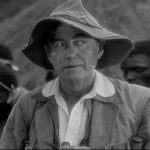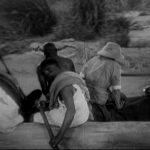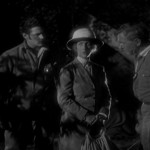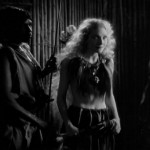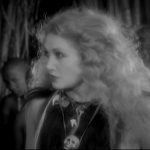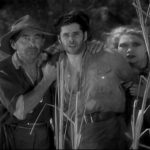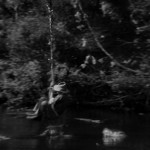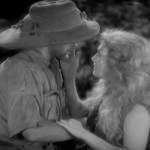
Trader Horn – 1930 / 1931
OK, there are so many places to start with this review. There were a number of aspects to this film that are worth mentioning. There are some juicy stories surrounding the film’s production. There is the surprising caliber of the acting, the production quality, the special effects, and the promotional short that accompanied the film. So much to cover!
Well, Trader Horn is about the adventures of Alfred Aloysius “Trader” Horn. A trader in the deep, dark jungles of Africa, Horn travels with his trusty native gun-bearer, Rencharo, played by Mutia Omoolu. A handsome young thrill-seeker named Peru accompanies them, played by Duncan Renaldo.
Along the way, they encounter a fearless missionary woman named Edith Trent, played by Olive Golden. She is searching for her long lost daughter. After Trent’s death, Horn and his companions find her. Having been raised by a tribe of African cannibals, Nina Trent, played by Edwina Booth, is now known as the White Goddess. She saves the white men and Rencharo from a horrible fate, and they help her escape back to the civilized world to which she has never been. Of course, love blooms between young Peru and Nina.
The plot was pretty standard and predictable, but what I found surprising was the quality of the acting. This movie was made in 1931. The silent era was not quite a thing of the past and the film industry, as a whole, was still trying to figure out how to make sound films. The actors still showed signs of the over-exaggerated facial expressions and body language that were necessary in silent films, but it wasn’t as bad as I was expecting. Booth was the worst offender, but really wasn’t bad at all.
The use of native African extras was both appropriate and surprising. The topless African women were featured unapologetically. Also, the animals of the African wilderness were a prominent part of the footage. In fact, Trader Horn has the distinction of being the first movie filmed on location in Africa that was not a documentary. There was a lot of realism about the dangers of the African wildlife.
And that brings me to the most jaw dropping parts of the film. Apparently, safety was not the main concern on the set of Trader Horn. Sure, there were plenty of rear projection shots in which the actors played out their scenes in front of a movie screen that had the background images projected onto the screen from the other side. But some of the stunts and animal dangers were real. I mean really real!
Here is a great quote from Wikipedia. “Many accidents occurred during filming in Africa. Many of the crew, including the director, contracted malaria. An African crewman fell into a river and was eaten by a crocodile. Another was killed by a charging rhino, which was captured on film and used in the movie. Swarms of insects, including locusts and tsetse fly were common.”
Edwina Booth also contracted some kind of infection, probably malaria, and had health problems which forced her to end her career as an actress. She sued MGM and settled out of court. Also, the scene where lead actor, Harry Carey, swings across a river and a croc takes a snap at his leg? Real. Seriously! And using the actual death by rhino in the final cut of the film?!? Good God!!
And then there was the short promotional film that was included on the DVD, which was nearly enough to make me hurl. They did a quick 10 or 15 minute version of the movie acted out by trained circus dogs with costumes and wigs. There were also grown adults in animal costumes doing silly things to add to the hokey dog comedy. After it was over, I felt ashamed for having watched the whole thing.
Still, the main feature was an alright film that had both an interesting plot, at least for the early 30s, and a pretty good cast. But there was no way it was worth the cost in lives that were lost to make it happen, Best Picture nomination or not!
